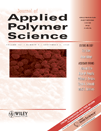Encapsulation of titanium dioxide in styrene/n-butyl acrylate copolymer by miniemulsion polymerization
Abstract
Miniemulsion copolymerization of styrene/n-butyl acrylate was investigated as a means of encapsulating hydrophilic titanium dioxide (TiO2) in a film-forming polymer. Dispersion studies of the TiO2 were first carried out to determine the choice of stabilizer, its concentration, and the dispersion process conditions for obtaining stable TiO2 particles with minimum particle size. Through screening studies of various functional stabilizers and shelf-life stability studies at both room and polymerization temperatures, Solsperse 32,000 was selected to give relatively small and stable TiO2 particles at 1 wt % stabilizer and with 20–25 min sonification. The subsequent encapsulation of the dispersed TiO2 particles in styrene/n-butyl acrylate copolymer (St/BA) via miniemulsion polymerization was carried out and compared with a control study using styrene monomer alone. The lattices resulting from the miniemulsion encapsulation polymerizations were characterized in terms of the encapsulation efficiencies (via density gradient column separations; DGC) and particle size (via dynamic light scattering). Encapsulation efficiencies revealed that complete encapsulation of all of the TiO2 by all of the polymer was not achieved. The maximum encapsulation efficiencies were 79.1% TiO2 inside 61.7% polystyrene and 63.6% TiO2 inside 38.5% St/BA copolymer. As the density of the particles collected from the DGC increased from one layer to another, both the average particle size and the number of the TiO2 particles contained in each latex particle increased. © 2006 Wiley Periodicals, Inc. J Appl Polym Sci 101: 3479–3486, 2006




